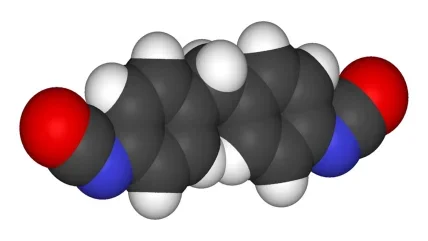
WBPI: Can you provide an update on the current regulatory status of MDI?
Erik Vangronsveld (EV), Huntsman’s global materials and industry sustainability director: Let me start with an update on my understanding of recent EU regulatory changes that impact the entire di-isocyanate industry, so not just MDI but also TDI (toluene di-isocyanate), HDI (hexamethylene di-isocyanate) and other di-isocyanates. I’m referring to the training and labelling restrictions.
The labelling restriction came into force on February 24, 2022, and the training restriction will come into force on August 24, 2023 (The EU introduces mandatory training of di-isocyanates workers from August 24 2023 in new REACH Restriction | ISOPA).
In summary, the new legislative measures mean that all di-isocyanate-based packaging containing more than 0.1% of di-isocyanates must now mention that mandatory training will be required, from August 24, 2023, onwards. This is applicable for all industrial and professional users handling these products to help minimise exposure risks and improve safe behaviours.
In anticipation of this legislation, ISOPA, the European Isocyanate and Polyol Producers Association, has been working extremely hard in this area. Together with more than 20 downstream associations, including the European Panel Federation (EPF), ISOPA has developed a general and application specific safe handling training programme for workers to follow, including composite wood companies. This training can be completed online on the ISOPA website (Safe use of Di-isocyanates – Homepage (safeusediisocyanates.eu).
For users where applications have potential increased exposure risk, a classroom-based approach training is recommended and available. Face-to-face training can be booked via the ISOPA platform or through your supplier. In addition, there is a possibility to become a certified trainer: something that those responsible for training people to handle di-isocyanates might like to consider.
As the August compliance date approaches, companies that have not yet communicated to their workers that they need to follow this training are encouraged to do so ASAP. We know that in some countries national authorities will check if training requirements have been followed. The legislation is clear. Users will also need to demonstrate that training has taken place by successfully completing a test, showing that they understand what is required. The ISOPA platform automatically leads users to a test once training has been completed. After August 24, 2023, personnel will not be allowed to handle di-isocyanates if they have not been trained via the type of content you can find on the ISOPA platform.
ISOPA training materials are already available in English, German, French, Spanish, Dutch, Italian and many other European languages.
WBPI: WHAT ELSE HAS CHANGED REGULATION-WISE?
EV: The next regulatory topic, which is also relevant for all types of di-isocyanates, is the proposed new Occupational Exposure Limit (OEL) for di-isocyanates. In March 2019, the European Commission asked the European Chemicals Agency (ECHA) to investigate how and to what extent the OEL for di-isocyanates could be altered to reduce the risk of di-isocyanate-induced occupational asthma cases. Today, EU Member States have different OEL levels for individual di-isocyanates across the European Union. Some even have no limit value at all. The industry welcomed a proposal to standardise the approach and establish a level playing field that would ensure a higher level of worker protection across the EU. In November 2021, the Advisory Committee on Safety and Health at work (ACSH), consisting of Member State experts and representatives of employers and trade unions, adopted a consensus on an OEL for di-isocyanates. They proposed a phased transition to comply with an 8-hour time-weighted average (8-hour TWA) of 10µg NCO /m³ by 2025 and 6µg NCO/m³ by 2029; plus a short-term exposure limit for 15min (STEL) of 20µg NCO/m³ by 2025 and 12µg NCO/m³ by 2029. The ACSH highlighted that the combination of the REACH Training Restriction with this new OEL would be the most efficient approach for preventing peak exposures.
Huntsman supports the new OELs and the staggered approach proposed by the Commission. We believe this approach reflects a consensus on the science and what is practically achievable between relevant stakeholders spanning regulators, unions, and the industry. It also gives those industries, which – based on monitoring data – are potentially at risk of not achieving limits, time to implement new exposure control measures.
For composite wood operations using MDI, there should – generally – be no significant impact on daily operations as MDI personal exposure levels are already typically low. At Huntsman, we have worked with our customers for many years to help to implement risk reduction measures in areas where there may be an increased risk.
However, it should be noted that there is a significant change in how to measure and report exposure. Currently, depending on the country you are in, you will be expected to report the potential exposure concentration as mg/m3 MDI or -NCO. Moving forward, users are expected to measure and report all -NCO species that are airborne as a sum of mg/m3 -NCO. It is therefore recommended that companies review if they will need to put additional risk management measures in place to protect workers and comply with the new OELs.
Timing-wise, the new OEL is not yet in force. The political approval process is expected to last until September 2023, when the final vote in the European Parliament is expected to take place, assuming there are no changes to its agenda. Once adopted, the current proposal is that Member States will have two years to transpose the directive into national law – taking us to the end 2025. This means changes to the proposal are still possible.
WBPI: What other updates are there?
EV: There is one more topic, related to a pilot project that the MDI REACH consortium, led by Huntsman, stepped into as part of a CEFIC (EU Chemical Industry Association) collaboration with ECHA. This relates to testing the grouping approach, where a group of similar chemicals are evaluated together, rather than substance
by substance.
This project started about two years ago and is still ongoing. The industry is generating data on all registered MDI substances using read-across principles, to demonstrate that all MDI substances can be treated as one group with regards to hazards and exposures and fall within the boundaries of a worst-case and best-case substance that have a full data-set. We are waiting for the ECHA to present its overall assessment and indicate where potential data gaps might exist. In the meantime, together with our consortium partners, Huntsman is proactively and intensively generating data to improve the data density of MDI dossiers, to help minimise the risk and number of potential ECHA data requests. We have no information from ECHA regarding the timing of the completion of its assessment.
WBPI: In summary, what are the key actions to take?
EV: If there are two key actions to highlight, I would say first and foremost, companies should ensure that all relevant employees are trained by August 24, 2023. Training can be completed at: https://www.safeusediisocyanates.eu/.
Secondly, with the new proposed staggered OEL reductions, we recommend assessing if your workplace stations and individual worker exposures are still in line with and (well) below these new limits.
To access ISOPA’s training materials, go to: Safe use of Di-isocyanates – Homepage (safeusediisocyanates.eu). For more information on di-isocyanate regulatory matters, or to obtain advice from an expert at Huntsman, please contact:
polyurethane_eu@huntsman.com l
About the interviewee:
Erik Vangronsveld – global materials and industry sustainability director
Erik Vangronsveld has a long track record in the polyurethanes industry. In a career that has spanned more than 30 years, he has worked at multiple PU plants across the world; been involved in the manufacture all kinds of PU products from automotive, bedding, insulation, and footwear systems to resins and binders for composite wood applications; and supported customers with product stewardship and the safe handling of MDI. Today, Mr Vangronsveld has global responsibility for regulatory affairs/advocacy, product stewardship and sustainability for Huntsman’s polyurethanes business division.






